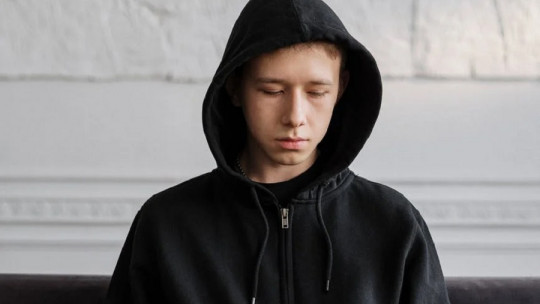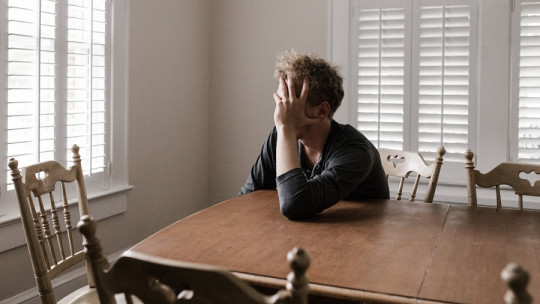
Suicide is a tragedy at any age. That a person takes his own life is a disgrace for everyone close to him, who wonders why he did it and how it was possible for it to happen.
Although there is increasing awareness of this social problem, few realize that elderly people also commit suicide, and there is still no focus on it.
Suicidal behavior in the elderly It is, sadly, a reality and quite common. Below we are going to delve deeper into the topic, looking at what are the main factors that influence your commission and some signs that an older person could plan to try to take their own life soon.
Suicidal behavior in the elderly
Suicidal behavior in the elderly is a scourge that has gone unnoticed for a long time, despite the fact that it has acquired proportions that openly speak of a new epidemic and, as such, it is necessary to control and prevent. In fact, all studies on suicide show that It is older people who have the highest rate of suicide and the lowest attempts.
In the particular case of Spain, the elderly only make 1 in 20 minor attempts, compared to 1 in 7 serious and 1 in 3-4 completed suicides. This can be interpreted as older people having stronger intentions to die, using more lethal means.
Not only is the high rate of completed suicides in the elderly worrying, but also how they do it. Many of them resort to what has been called “silent suicide” or “slip syndrome,” which could be interpreted as letting themselves die passively. The person refuses food and medical care, abandoning themselves until they die. Just because it is slower does not mean that it is less lethal than active suicide, since the intention to die is the same and is equally worrying.
Risk factors for suicidal behavior in old age
There are a series of risk factors that increase the possibility of an elderly person attempting suicide. These conditions, both personal and circumstantial, if seen in time, can help us prevent an elderly person from taking their own life. It should also be said that suicide is something difficult to predict on many occasions, but Keeping these factors in mind can help prevent it in old age..
Among the factors that increase the risk of suicidal behavior in the elderly, we find the following as the main ones:
1. Advanced Age
In industrialized countries, the suicide rate increases with age. This is especially noticeable in people over 65 years of age, coinciding with the retirement age in many countries.. It is from that age onwards that the suicide rate rises noticeably.
2. Male gender
About 80% of suicides in the elderly are committed by men. On average, for every woman who ends her life, three to four men do so. However, women are at greater risk of suicide attempts. The most common explanation for this is that retirement and the physical deterioration of old age are experienced in a much more negative and disturbing way in men than in women.
3. Relatives who committed suicide
Family history of suicide whether in the family nucleus itself or in the extended family, increases the risk of committing it. This can be explained because, on the one hand, a psychological disorder may have been inherited that increases the risk of committing suicide (e.g., depression, schizophrenia…) and, on the other, certain models have been learned in the family that conceive suicide as the only alternative to the worst crises (e.g., chronic unemployment, terminal illness, debt…).
4. Death of a loved one
The death of a loved one increases the risk of suicide, with widowhood being the most common case in the elderly. The circumstances of the death of the loved one and the type of relationship that was had with them determine how the mourning will occur. dIf this grief becomes more complicated, there is a chance that it will turn into major depression. and, consequently, the risk of suicide increases.
5. Living or feeling alone
There have been studies that have pointed out that about half of the elderly who committed suicide lived alone. Some have argued that the variable that best correlates with suicidal behavior is living alone; however, there are also many older people who live alone and do not end their lives nor do they seem to have any intention of doing so. This could be explained because, although they live alone, they may have an intense social network and not feel alone or helpless.
The lack of friends, the poor relationship with family and other variables associated with having a lonely life has been linked to suicidal behavior. People over 65 years of age, especially widows, are the demographic group most at risk of social disengagement, something that, combined with a lack of economic and social resources or suffering from a chronic illness, increases the risk of committing suicide.
- Related article: “Unwanted loneliness: what it is and how we can combat it”
6. Suicide threats
Expressed desires to harm oneself and threats are among the most important indicators of suicide risk. To this day there is still an erroneous belief, committed by many family members, friends and even professionals, that if a person talks about suicide or says he is going to commit suicide, he will never do it. The reality is just the opposite: most people who end their lives have communicated, in one way or another, that they wanted to die to their family and friends.
7. History of previous suicide attempts
Previous suicide attempts increase the risk of committing it in old age. Nearly a third of people who ended their lives had previously attempted suicide.. In many cases, these attempts are a way to get help and be taken into account rather than a real attempt to end their life. However, if there have been any, close attention must be paid because it may be the prelude to what they will finally end up doing.
8. Chronic pain, chronic and/or terminal illness
A risk factor for suicide is suffer from a chronic illness, especially if this represents some type of disability or incapacity for the elderly. More than half of those over 65 years of age who commit suicide have some type of chronic and disabling illness.
- Related article: “Chronic pain: what it is and how it is treated from Psychology”
9. Alcoholism and other addictions
In the general population, alcohol abuse disorder is among the most important suicidal risk factors. Even without dependence, alcohol consumption increases the risk of committing suicide. The statistics vary a little in this regard, seeing that between 20 and 70% of people who have committed suicide have alcohol in their blood.
- You may be interested: “Alcoholism: these are the effects of dependence on drinking”
Indicators of suspected imminent suicide
Although for many, suicide in the elderly may seem like an impulsive act, the truth is that it is usually planned in advance. Despite this, it is difficult to determine the exact moment when an elderly person will try to take their own life. Many relatives of people who have ended their own lives They often comment that he or she did not behave differently the day he or she did it.nor did he seem to have a different mood than usual.
What makes an older person decide to end their life may be seen as something trivial from the outside, but that the person attributed with great importance: a disapproving comment, not being able to do a task well, reproaching them for being retired, not being able to taking care of the grandchildren, needing a wheelchair…
However, we can highlight some indicators prior to suicidal behavior that can warn us that the elderly person is thinking about taking their own life. The most notable are the following.
1. Interest in death or suicide
Before the act, the person may express a special interest in death or suicide itself. What he is doing is probably seeking information on the most effective method to end his life.
2. Talk about suicide
Bringing up suicide should be seen as a worrying indicator. Constantly talking about wanting to die or wanting to end your life are indications of a possible attempt. Expressions such as “I can’t take it anymore”, “I’m not going to last like this for long”, “there is no solution for me, I’m too old” are also signs of this… These and other worrying expressions should be seen as signs that he could try to end his life and we must be especially careful..
3. Strange goodbyes
Another obvious manifestation of a probable suicide attempt is saying goodbye to family and friends for no apparent reason. Goodbyes can be verbal and it seems like you are saying it as if you were going on a trip soon..
Expressions such as “I imagine I will never see you again”, “take care of my things”, “I love you very much and I will miss you” in an older person should set off alarms. They can also call old acquaintances on the phone that they have not had a relationship with for years or write farewell letters, notes, e-mails…
4. Drafting of the will
In an attempt to leave everything in order before leaving, elderly people who could commit suicide shortly They can write the will or review it. They can also handle other financial matters and posthumous wishes.

5. Strange behaviors
Among suspicious or unusual behaviors we can mention:
- Accumulation of drugs that you do not need.
- Document yourself to know lethal doses of over-the-counter drugs.
- Reducing contact with people who care for you.
- Try to be alone, to practice your suicide plan and see if you have time.
- Visit the doctor without an appointment.
- Making an unjustified trip to the pharmacy.
- Going out alone without apparent explanation.
6. Apparent improvement or spontaneous recovery
Many people who end up committing suicide appear calm, happy, or even euphoric in the days before their death.. It is common for family members to comment that his suicide surprised them because, in the days before it, they saw the eldest as happier.
The explanation for this is that, after spending a long time with the uncertainty of whether or not to end his life, at the moment he decides that he is going to do it and specifies a day, as he sees that the end of his suffering is approaching, He lives it with a little happiness.
Suicide in the elderly and psychopathologies
The presence of psychopathology is in itself a powerful factor in the risk of committing suicide, at any age. There are several mental disorders that have been identified as responsible for suicidal behavior in the elderly. Among them it is worth highlighting the following.
1. Depression
Depression is the mental disorder most strongly linked to suicide, especially in the elderly. Between 60 and 90% of older people who attempt suicide show depressive symptoms and depression is considered the first cause of risk. Patients with depression are 4 times more likely to commit suicide than those with other mental disorders.
Depressive symptoms in the elderly are characterized because they are not of great intensity, which makes it more difficult to detect them. Furthermore, in many cases the depressive episode that leads to suicide may be the first that the individual has experienced and does not usually present with psychotic symptoms. This makes it difficult to make an early diagnosis that can prevent a suicide attempt.
Although in general older people present depressive symptoms similar to those of the rest of the adult population, some differences can be highlighted such as:
- More somatic complaints
- More hypochondriacal symptoms
- Less depressed mood
- Hopelessness
- Insomnia and other sleep problems
- Less frequent feelings of guilt
- More memory errors
- More susceptible to criticism
2. Schizophrenia
Schizophrenia has been directly linked to suicide. This is due to several reasons: it has a poor prognosis, it causes a continuous drain on personal, family and social resources, it is chronic and, above all, it is difficult to treat. Between 10 and 15% of people who commit suicide had a diagnosis of schizophrenia.
Traditionally, much importance had been given to the appearance of auditory hallucinations that ordered the person to commit suicide. However, these cases are relatively uncommon in people with schizophrenia who end up committing suicide (5%). It is rather the negative situations and social isolation that induce suicide in this population.
3. Alcoholism
As we have mentioned before, alcohol abuse is a serious health problem and is even more so in the elderly population and one of the most important risk factors for suicide. Some statistics suggest that About 25% of older people who had attempted suicide had consumed alcohol before the attempt.
Added to this, older people who abuse alcohol often have depressive problems. Precisely, it is this combination of alcohol and depression that is responsible for many suicide attempts.
Medical illnesses and suicidal behavior in the elderly
There is a strong correlation between somatic illnesses and suicide. Having a serious medical illness increases the risk of attempting to take one’s own life, either due to the characteristics of the illness itself, the consumption of drugs that generate a depressive state and, therefore, a greater risk of suicide, or the appearance of depressive disorders. associated, especially if the disease is chronic, painful or terminal.
The diseases that most increase suicidal behavior in the elderly are the following.
1. Neurological
Neurological diseases, such as Alzheimer’s and Parkinson’s dementia, are an important factor associated with suicide in the elderly. Parkinson’s is of special mention, since about half of the patients with this condition present depressive symptoms. Added to this, some medications for this neurological disease can facilitate the appearance of depressive symptoms.
2. Rheumatic
The main one is rheumatoid arthritis, which is characterized by chronic pain., pain that is in itself one of the major risk factors for self-injurious behavior. If, in addition to this chronic pain, there is a serious, progressive disability with deformities, an alteration in body image can occur that directly influences self-esteem and greater social isolation.
3. Oncological
The suicide rate among cancer patients is 20 times higher than the rest of the population. Between 30 and 40% of people with cancer suffer from depressive symptoms. Oral, pharyngeal and lung cancer, genital, digestive and breast neoplasms are the oncological diseases with the highest risk of suicidal behavior in the elderly.
4. Gastrointestinal
peptic ulcer It is one of the gastrointestinal diseases most found in people who have committed suicide. This disorder is related to the prevalence of alcoholism. Also, although to a lesser extent, we have liver cirrhosis and Crohn’s disease as diseases related to suicide.
5. Cardiovascular
Statistics indicate that About 10 to 15% of suicide cases presented cardiovascular pathologies, such as myocardial infarction and high blood pressure. An added problem to this type of pathology is that the treatment is carried out with drugs that have symptoms of depression as side effects. If, before developing cardiovascular disease, the person suffered from depression, the risk of suicide increases.
Prevention of suicidal behavior in the elderly
Many times, suicide in old age is caused by a depressive disorder, a psychiatric condition that can be treated. and, therefore, prevent its tragic end. To prevent this problem, it would be recommended that every professional who interacts with elderly people have the ability to identify the symptoms of depression and initiate an entire action protocol to send patients to a psychologist or psychiatrist, who will diagnose the condition and will treat her.
Detection and suspicion would fall primarily on medical professionals, since it is known that a very high percentage of seniors who end up committing suicide visited their doctor that week or even days before committing the act. However, other people not so involved in the healthcare field, such as home caregivers, could receive training to ensure that they have the necessary tools to suspect that an elderly person might try to end their life.
It is especially important put the spotlight on the elderly who live alone. This population is especially sensitive to trying to end their life, in their desperation at feeling isolated from the rest of the world or feeling that they no longer have anything to contribute to their environment. They should not be forced to live in company or end up in a residence, but they should be encouraged to interact with other people in social activities such as dance groups, painting workshops or outdoor sports. Greater contact and closeness prevents feelings of loneliness and, consequently, suicide.








